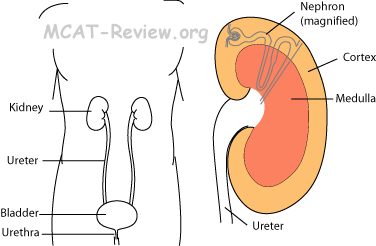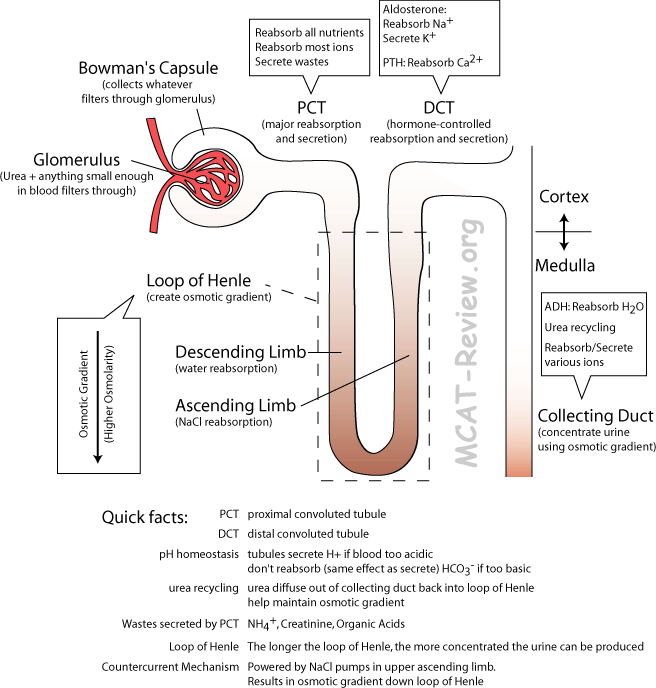|
|
Roles in homeostasis
- blood pressure
- If blood pressure too low:
- Renin-angiotensin pathway: Kidney (JGA cells) release renin, triggers formation of angiotensin II, which stimulates aldosterone release, the end result is to raise blood pressure.
- Aldosterone (aka mineralocorticoid): Adrenal glands release aldosterone, causes kidney (distal tubules) reabsorb more Na+, which in turn causes more water reabsorption.
- ADH (made in hypothalamus, stored in pituitary): causes more water reabsorption in the kidney tubules, raising blood pressure. High levels also cause vasoconstriction.
- If blood pressure too high, all the above hormones stop releasing. Also, the heart can release ANP (Atrial natriuretic peptide), which antagonizes aldosterone and cause kidney to excrete both more Na+ and more water. ANP can also cause vasodilation.
- osmoregulation
- Blood plasma is mainly Na+ and Cl- (Inside cells is mainly K+ and hydrogen phosphate ions).
- Blood osmolarity is determined predominantly by Na+ and Cl-.
- Blood osmolarity too low → aldosterone, reabsorb Na+. Cl- follows.
- Kidney tubules' secretion and reabsorption regulates osmolarity.
- Other ions
- K+ is regulated by aldosterone.
- Aldosterone: reabsorb Na+, pee out K+
- Calcium and phosphate regulated by PTH.
- PTH = parathyroid hormone = more Ca2+ reabsorption in kidney tubules (also, bone break down to release calcium and phosphates, and small intestine to absorb more calcium).
- acid-base balance: keep blood pH constant.
- Buffer systems: Bicarbonate buffer system (blood and extracellular fluid), Phosphate Buffer System (inside cells)
- CO2 + H2O ↔ H2CO3 ↔ H+ + HCO3-
- Breathing out CO2 decreases the acidity in blood.
- Kidney tubules:
- Bicarbonate ion (HCO3-): peeing it out makes blood more acidic. Reabsorption makes blood more basic. (not the other way round, use Le Chatelier's principle, or simply note that bicarbs bind H+, so they have the opposite effect on pH)
- H+ secretion gets rid of acidity.
- removal of soluble nitrogenous waste
- Urine = concentrated urea in water, with some salt.
- Urea = harmless form of toxic ammonia = nitrogenous waste.
- Amino acids → Ammonia → Urea → peed out.
Kidney structure

- cortex = outer shell of kidney = contains the convoluted tubules.
- medulla = inner part of kidney = contains loop of Henle.
Nephron structure

- Nephron = functional unit of kidney = glomerulus, Bowman's capsule, proximal tubule, loop of Henle, distal tubule, collecting duct (shared by many nephron).
- glomerulus = ball of fenestrated capillaries.
- Bowman's capsule = Cup/Capsule that surrounds the glomerulus.
- proximal tubule = convoluted tubule on the side of the Bowman's capsule = the major site for reabsorption (nutrient, salts and water) and secretion (except for K+, the secretion of which is the job of distal convoluted tubule in response to aldosterone).
- loop of Henle = U shaped loop that dips into the renal medulla = countercurrent multiplier mechanism occurs here
- Descending limb = water reabsorption by osmosis (permeable to water, but not to solute).
- Bottom of U = most concentrated.
- Ascending limb = salt reabsorption (permeable to salt, but not water).
- distal tubule = convoluted tubule on the side of the collecting duct = hormone-controlled (fine tunes the work done by the proximal tubule) reabsorption of salts and water. Aldosterone-controlled secretion of K+
- collecting duct = the distal tubules of many nephrons drain here = ADH-controlled reabsorption of water, hormone-controlled reabsorption/secretion of salts.
Formation of urine
- glomerular filtration
- Powered by hydrostatic pressure.
- Both good stuff, bad stuff and ions are filtered out, as long as it's small enough.
- Good stuff: nutrients
- Bad stuff: urea (and creatinine and uric acid)
- Good stuff reabsorbed, bad stuff peed out.
- secretion and reabsorption of solutes
- Proximal convoluted tubules reabsorb all the good stuff (nutrients) and most of the ions. Bad stuff left in the filtrate (urea) to be peed out, also actively excreted (NH4+, creatinine, organic acids).
- Loop of Henle reabsorbs water and salt using the countercurrent mechanism.
- Distal convoluted tubules selectively reabsorb or secrete stuff based on hormonal control.
- Collecting duct reabsorb water to concentrate urine if ADH present. (Also can secrete and reabsorb stuff based on hormonal control)
- Regulation of blood pH: secrete H+ when blood too acidic, pee out (don't reabsorb) HCO3- when blood too basic.
- concentration of urine
- The distal convoluted tubule contains dilute solution of urea.
- The collecting duct concentrates it by water reabsorption (facilitated diffusion) when ADH is present.
- Water reabsorption in the collecting duct is possible because the loop of Henle has very high osmolarity (very concentrated) at the bottom.
- countercurrent multiplier mechanism (basic function)
- What does the Countercurrent multiplier do? It creates an osmotic gradient down the loop of Henle, which is used by the collecting duct to concentrate urine.
- What drives the creation of this gradient? NaCl pump on ascending limb.
- What's countercurrent? Descending limb: water flow out of filtrate, impermeable to salt. Ascending limb: salt flow out of filtrate, impermeable to water.
- What's multiplier? The gradient-producing power of each individual NaCl pump multiplies down the length of the loop of Henle. Longer the loop of Henle, greater the osmotic gradient, more concentrated urine can be produced.
- What is urea recycling? Urea at the bottom of collecting duct leaks out into the interstitial fluid and back into the filtrate. Contributes to the high osmolarity at the bottom of the loop of Henle.
Storage and elimination (ureter, bladder, urethra)
- Collecting ducts drain into the ureter.
- Ureters drain into the bladder.
- Bladder stores urine: its special epithelium (transitional epithelium) can squish to accommodate storage of large amounts of urine.
- Urine gets peed out of the bladder through the urethra.
|
|
